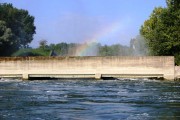
Sampling by the large nuclear power plant at Paks witnessed an amazing multi-coloured rainbow indicating that warm water from the plant's cooling towers is entering the Danube. An abundance of mussels in the neighbourhood was also detected.
On the Sio River, sampling found this Danube tributary to be significantly polluted by nutrients, as evidenced by the strong colours that resulted during testing of the water using spectrophotometric analysis.
Later that evening, the whole Core Team and crew of the Széchenyi seized on the opportunity to dine at one of Baja's typical fish restaurants, eating Hungary's most prized fish soup (halászlé) and other fish delicacies, many from the Danube.
However, just before at 18:00, the team realized that the only two sieves (one a backup) used for sampling sediments for chemical analyses had broken. This was a big problem given that this particular form of testing comprised a significant component of the overall JDS2. Furthermore, a special mesh size for the sieve was required to meet EU sampling standards. In response, the team phoned the Water Research Institute in Bratislava which reacted immediately. They promised to meet a JDS2 car at the Institute early the next morning with sieves, so that the car could get back to the JDS2 ships near the Hungarian-Croatian border by early afternoon, and continue the valuable sampling.





















